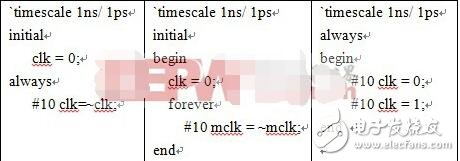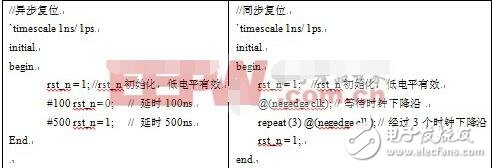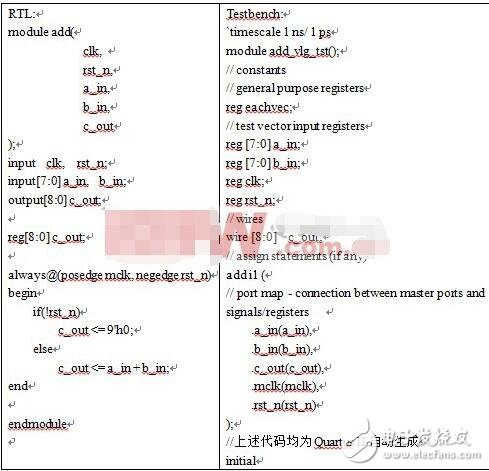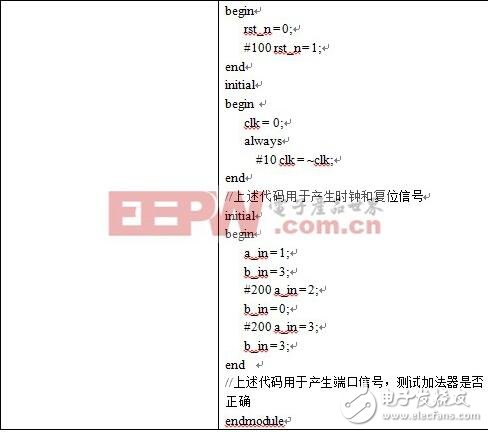

testbench怎么写_testbench经典教程VHDL
电子常识
描述
testbench是一种验证的手段。首先,任何设计都是会有输入输出的。但是在软环境中没有激励输入,也不会对你设计的输出正确性进行评估。那么此时便有一种,模拟实际环境的输入激励和输出校验的一种“虚拟平台”的产生。在这个平台上你可以对你的设计从软件层面上进行分析和校验,这个就是testbench的含义。
testbench怎么写
一个最基本的Testbench包含三个部分,信号定义、模块接口和功能代码。借用一下特权同学总结的编写Testbench的三个基本步骤:
1、对被测试设计的顶层接口进行例化;
2、给被测试设计的输入接口添加激励;
3、判断被测试设计的输出相应是否满足设计要求。
逐步解决编写Testbench的这三点:
首先“对被测试设计的顶层接口进行例化”,这一步相对比较简单,例化就是,但端口多时也够喝一壶的,而且要分wire、reg,有时会弄错,别难过,其实可以偷个懒,通过Quartus II自动生成一个Testbench的模板,选择Processing -》 Start -》 Start Test Bench Template Writer,等待完成后打开刚才生成的Testbench,默认是保存在simulation\Modelsim文件夹下的.vt格式文件。这一步就不多讲了,偷懒就挺好。
其次“给被测试设计的输入接口添加激励”,一般时序设计必然涉及到最基本的两个信号——clk、rst_n(时钟、复位),肯定有童鞋会讲可以没有rst_n,是可以没有,但何必呢,让代码更健壮一点不很好嘛,别钻牛角尖。下面攻克clk、rst_n的写法:
首先先讲一下timescale,因为想要进行仿真首先要规定时间单位,而且最好在Testbench里面统一规定时间单位,而不要在工程代码里定义,因为不同的模块如果时间单位不同可能会为仿真带来一些问题,而timescale本身对综合也就是实际电路没有影响。 `timescale 1ns/ 1ps表示仿真的单位时间为1ns,精度为1ps。

上述三种代码的目的就是产生系统时钟,给clk一个初值后,不断重复执行:每10ns翻转一次clk,从而生成一个周期为20ns,频率50MHz的方波信号。第一、二种基本类似,第三种比较简单,少了一个initial,放在了always里初始化。
三种方法都无一例外地给clk赋了初值,因为信号的缺省值为Z,如果不赋初值,则反相后还是Z,时钟就一直处于高阻Z状态。小编同学一般选中第一种,看个人喜欢。
根据复位方式的不同,rst_n一般有两种写法:

上述两种代码的目的基本都是延时复位,但一个异步复位,一个同步复位,用途不同,小编同学一般使用异步复位。
最后“判断被测试设计的输出相应是否满足设计要求”。首先介绍最常用的两个系统任务函数$stop和$finish。$stop代表暂停仿真后返回软件操作主窗口,将控制权交给user;$finish代表终止仿真后关闭软件操作主窗口。其他任务函数如$monitor、$display 、$time、$fwrite等也比较重要,用到的时候再一一介绍。为直观介绍,使用一个例程来描述,下面是加法器的RTL代码及Testbench:


注意了clk、rst_n后,其他端口根据需要相应加测试信号即可,然后把RTL代码及Testbench添加到Modelsim仿真观察输出波形等,以验证RTL代码的正确与否,若与预期相符则验证结束,反之则修改代码至与预期相符。
好了,Testbench就写到这里,但没有结束,实践是检验真理的唯一标准,下一篇将结合Modelsim,以可视化的方式继续探讨Testbench,深入了解仿真的意义。
testbench经典教程VHDL
library ieee;
use ieee.std_logic_1164.all;
use ieee.std_logic_arith.all;
--use ieee.std_logic_unsigned.all;
entity cnt6 is
port
(clr,en,clk :in std_logic;
q :out std_logic_vector(2 downto 0)
);
end entity;
architecture rtl of cnt6 is
signal tmp :std_logic_vector(2 downto 0);
begin
process(clk)
-- variable q6:integer;
begin
if(clk‘event and clk=’1‘) then
if(clr=’0‘)then
tmp《=“000”;
elsif(en=’1‘) then
if(tmp=“101”)then
tmp《=“000”;
else
tmp《=unsigned(tmp)+’1‘;
end if;
end if;
end if;
q《=tmp;
-- qa《=q(0);
-- qb《=q(1);
-- qc《=q(2);
end process;
end rtl;
六进制计数器testbench的代码
library ieee;
use ieee.std_logic_1164.all;
entity cnt6_tb is
end cnt6_tb;
architecture rtl of cnt6_tb is
component cnt6
port(
clr,en,clk :in std_logic;
q :out std_logic_vector(2 downto 0)
);
end component;
signal clr :std_logic:=‘0’;
signal en :std_logic:=‘0’;
signal clk :std_logic:=‘0’;
signal q :std_logic_vector(2 downto 0);
constant clk_period :time :=20 ns;
begin
instant:cnt6 port map
(
clk=》clk,en=》en,clr=》clr,q=》q
);
clk_gen:process
begin
wait for clk_period/2;
clk《=‘1’;
wait for clk_period/2;
clk《=‘0’;
end process;
clr_gen:process
begin
clr《=‘0’;
wait for 30 ns;
clr《=‘1’;
wait;
end process;
en_gen:process
begin
en《=‘0’;
wait for 50ns;
en《=‘1’;
wait;
end process;
end rtl;
其实testbench也有自己固定的一套格式,总结如下:
--测试平台文件(testbench)的基本结构
library ieee;
use ieee.std_logic_1164.all;
entity test_bench is --测试平台文件的空实体(不需要端口定义)
end test_bench;
architecture tb_behavior of test_bench is
component entity_under_test --被测试元件的声明
port(
list-of-ports-theri-types-and-modes
);
end component;
begin
instantiation:entity_under_test port map
(
port-associations
);
process() --产生时钟信号
……
end process;
process() --产生激励源
……
end process;
end tb_behavior;
-------------------------------------------------------------------
--简单计数程序源码
library ieee;
use ieee.std_logic_1164.all;
use ieee.std_logic_unsigned.all;
use ieee.std_logic_unsigned.all;
entity sim_counter is
port(
clk :in std_logic;
reset :in std_logic;
count :out std_logic_vector(3 downto 0)
);
end entity;
architecture behavioral of sim_counter is
signal temp :std_logic_vector(3 downto 0);
begin
process(clk,reset)
begin
if reset=‘1’ then
temp《=“0000”;
elsif clk‘event and clk=’1‘ then
temp《=temp+1;
end if;
end process;
count《=temp;
end behavioral;
-------------------------------------------------------------------
--简单计数程序,测试文件代码(testbench)
library ieee;
use ieee.std_logic_1164.all;
use ieee.std_logic_unsigned.all;
use ieee.numeric_std.all;
entity counter_tb_vhd is --测试平台实体
end counter_tb_vhd;
architecture behavior of counter_tb_vhd is
--被测试元件(DUT)的声明
component sim_counter
port(
clk :in std_logic;
reset :in std_logic;
count :out std_logic_vector(3 downto 0)
);
end component;
--输入信号
signal clk:std_logic:=’0‘;
signal reset :std_logic:=’0‘;
--输出信号
signal count :std_logic_vector(3 downto 0);
constant clk_period :time :=20 ns; --时钟周期的定义
begin
dut:sim_counter port map(
clk=》clk,reset=》reset,counter=》counter
);
clk_gen:process
begin
clk=’1‘;
wait for clk_period/2;
clk=’0‘;
wait for clk_period/2;
end process;
tb:process --激励信号
begin
wait for 20 ns;
reset《=’1‘;
wait for 20 ns;
reset《=’0‘;
wait for 200 ns;
wait; --will wait forever;
end process;
end;
--激励信号的产生方式
--1.以一定的离散时间间隔产生激励信号的波形
--2.基于实体的状态产生激励信号,也就是说基于实体的输出响应产生激励信号
--两种常用的复位信号
--1.周期性的激励信号,如时钟
--2.时序变化的激励型号,如复位
--eg.产生不对称时钟信号
w_clk《=’0‘ after period/4 when w_clk=’1‘ else
’1‘ after 3*period/4 when w_clk=’0‘ else
’0‘;
--eg.产生堆成时钟信号,process语句
clk_gen1:process
constan clk_period := 40 ns;
begin
clk=’1‘;
wait for clk_period/2;
clk=’0‘;
wait for clk_period/2;
end process;
如果自己不想写这些testbench的这些固定格式,可以在SIE里自动生成testbench文件的模板
步骤:New Surce -》 VHDL Test Bench, 然后才会生成testbench
自动生成的testbench模板格式如下:
-- Copyright (C) 1991-2008 Altera Corporation
-- Your use of Altera Corporation‘s design tools, logic functions
-- and other software and tools, and its AMPP partner logic
-- functions, and any output files from any of the foregoing
-- (including device programming or simulation files), and any
-- associated documentation or information are expressly subject
-- to the terms and conditions of the Altera Program License
-- Subscription Agreement, Altera MegaCore Function License
-- Agreement, or other applicable license agreement, including,
-- without limitation, that your use is for the sole purpose of
-- programming logic devices manufactured by Altera and sold by
-- Altera or its authorized distributors. Please refer to the
-- applicable agreement for further details.
-- ***************************************************************************
-- This file contains a Vhdl test bench template that is freely editable to
-- suit user’s needs .Comments are provided in each section to help the user
-- fill out necessary details.
-- ***************************************************************************
-- Generated on “03/13/2011 20:05:04”
-- Vhdl Test Bench template for design : cnt6
--
-- Simulation tool : ModelSim (VHDL)
--
LIBRARY ieee;
USE ieee.std_logic_1164.all;
ENTITY cnt6_vhd_tst IS
END cnt6_vhd_tst;
ARCHITECTURE cnt6_arch OF cnt6_vhd_tst IS
-- constants
-- signals
SIGNAL clk : STD_LOGIC;
SIGNAL clr : STD_LOGIC;
SIGNAL en : STD_LOGIC;
SIGNAL q : STD_LOGIC_VECTOR(2 DOWNTO 0);
COMPONENT cnt6
PORT (
clk : IN STD_LOGIC;
clr : IN STD_LOGIC;
en : IN STD_LOGIC;
q : OUT STD_LOGIC_VECTOR(2 DOWNTO 0)
);
END COMPONENT;
BEGIN
i1 : cnt6
PORT MAP (
-- list connections between master ports and signals
clk =》 clk,
clr =》 clr,
en =》 en,
q =》 q
);
init : PROCESS
-- variable declarations
BEGIN
-- code that executes only once
WAIT;
END PROCESS init;
always : PROCESS
-- optional sensitivity list
-- ( )
-- variable declarations
BEGIN
-- code executes for every event on sensitivity list
WAIT;
END PROCESS always;
END cnt6_arch;
- 相关推荐
- 热点推荐
- vhdl
-
编写高效Testbench的指南和示例2024-10-29 2860
-
VHDL与Verilog硬件描述语言TestBench的编写2023-09-09 2561
-
Verilog Testbench怎么写 Verilog Testbench文件的编写要点2023-08-01 5678
-
testbench是什么? testbench测试的机制是什么?2023-06-28 6489
-
VHDL与Verilog硬件描述语言如何用TestBench来进行仿真2021-08-04 4665
-
如何使用VHDL实现testbench的编写2020-12-14 973
-
关于VHDL的testbench仿真问题2017-09-29 3120
-
testbench_book2016-12-13 745
-
怎样用VHDL写TESTBENCH2016-11-23 754
-
怎么给vhdl的testbench指导文件?2015-10-09 3110
-
请问modelsim的testbench用VHDL如何编写2013-12-15 3046
-
怎样在Verilog写的testbench测试VHDL模块??2013-08-01 7742
-
ModelSim TestBench VHDL参考模板2012-08-12 2872
-
怎样写testbench-xilinx2010-02-09 691
全部0条评论

快来发表一下你的评论吧 !

